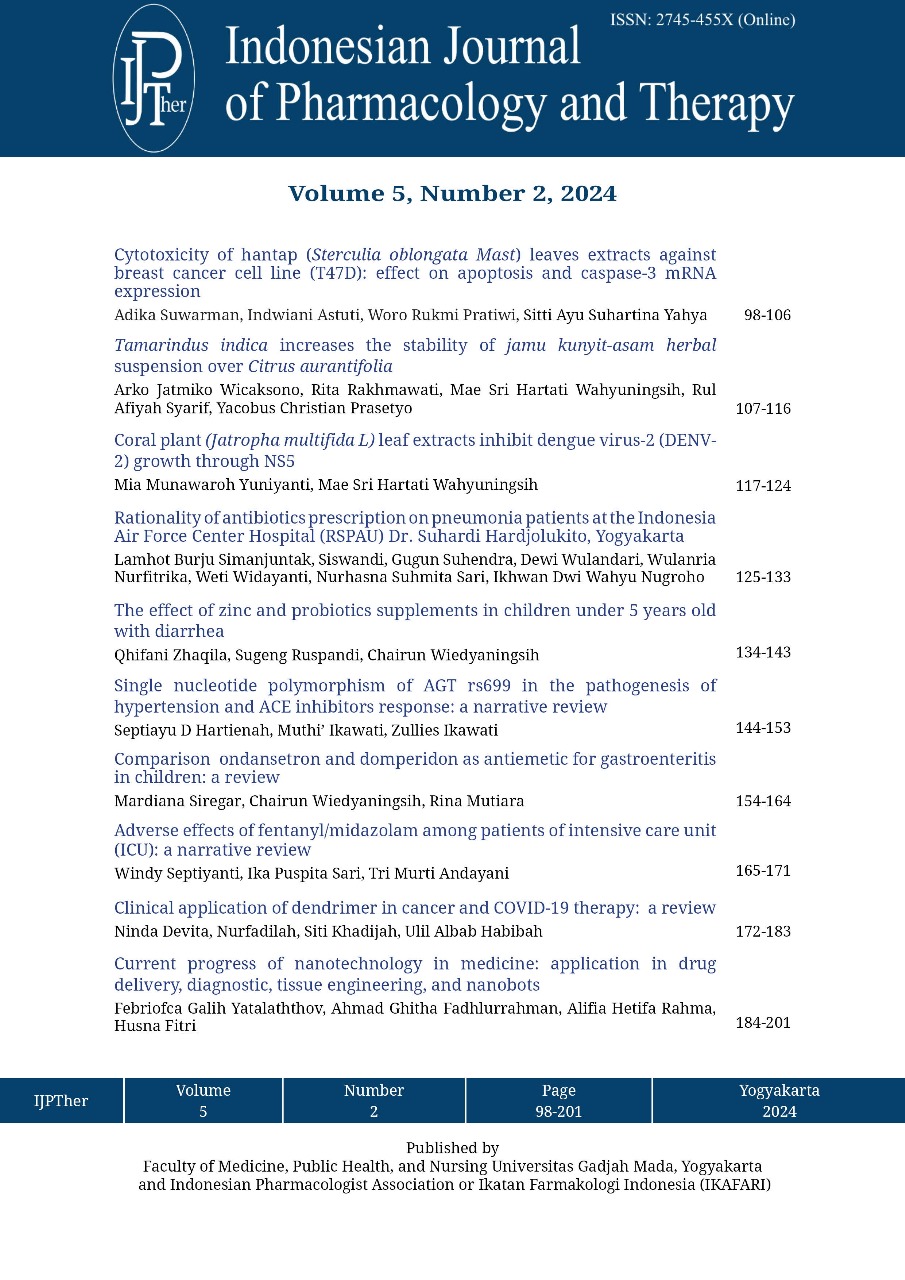Coral plant (Jatropha multifida L) leaf extracts inhibit dengue virus-2 (DENV-2) growth through NS5
Abstract
The incidence of dengue fever (DF) increases drastically from year to year, especially in tropical countries like Indonesia. In contrast, antiviral against dengue virus (DENV) is not available in clinics, yet. Jatropha multifica L, locally named tanaman yodium/coral plant, is a medicinal plant that is traditionally used to treat dengue hemorrhagic fever (DHF). However, its scientific evidence is limited. This study aimed to investigate the antiviral activity of J. multifida L leaf extracts against DENV-2 and evaluate the effect on NS5 RNA expression. The leaf extracts were prepared by multilevel extraction using chloroform and methanol. The study was conducted in vitro using DEN-2 and Vero cells. The antiviral activity was assessed by using qRT-PCR to assess the number of virus copies and then used to calculate the inhibitory concentration of 50% (IC50). The effect of the most active extract on NS5 DENV-2 RNA expression was then evaluated by using qRT-PCR. Among 4 extracts tested, the methanolic insoluble chloroformic extract (MIS) is the most active with an IC50 value of 124.3 μg/mL. Furthermore, the MIS (0.02) strongly inhibited NS5 DENV-2 RNA expression compared to control (1.0). In conclusion, the MIS of J. multifida is active against DENV-2 through inhibition of NS5 RNA expression.
References
Roy SK, Bhattacharjee S. Dengue virus: Epidemiology, biology, and disease aetiology. Can J Microbiol. 2021;67(10):687-702.
https://doi.org/10.1139/cjm-2020-0572
WHO. Dengue and Severe Dengue [Internet]. 2023 [cited 2023 Aug 21]. Available from: https://www.who.int/news-room/fact-sheets/detail/dengue-and-severe-dengue
Adams L. Dengue Epidemiology : Globally and in the United States. In: Advisory Committee on Immunization Practices: Dengue Vaccine Workgroup. United States: Centers for Disease Control and Prevention; 2022.
Jiang L, Liu Y, Su W, Cao Y, Jing Q, Wu X, et al. Circulation of genotypes of dengue virus serotype 2 in Guangzhou over a period of 20 years. Virol J [Internet]. 2022;19(1):1-9. https://doi.org/10.1186/s12985-022-01773-7
Norazharuddin H, Lai NS. Roles and prospects of dengue virus nonstructural proteins as antiviral targets: An easy digest. Malaysian J Med Sci. 2018;25(5):6-15.
https://doi.org/10.21315/mjms2018.25.5.2
Low JGH, Ooi EE, Vasudevan SG. Current status of dengue therapeutics research and development. J Infect Dis. 2017;215(Suppl 2):S96-102.
https://doi.org/10.1093/infdis/jiw423
Atanasov AG, Zotchev SB, Dirsch VM, Orhan IE, Banach M, Rollinger JM, et al. Natural products in drug discovery: advances and opportunities. Nat Rev Drug Discov. 2021;20(3):200-16.
https://doi.org/10.1038/s41573-020-00114-z
Yuniyanti MM, Nugrahaningsih DAA, Wahyuningsih MSH. Phytochemical screening and antidengue activity of Jatropha multifida extract against DENV-2. Maj Obat Tradis 2022;27(1):75.
https://doi.org/10.22146/mot.73368
de Carvalho C, Vieira Mariano L, S Negrão V, Passarelli Gonçalves C, Cristina Ribeiro Marcucci M. Phenols, flavonoids and antioxidant activity of Jatropha multifida L. collected in Pindamonhangaba, Sao Paulo State, Brazil. J Anal Pharm Res. 2018;7(5):581-4.
https://doi.org/10.15406/japlr.2018.07.00286
10. Zhu JY, Zhang CY, Dai JJ, Rahman K, Zhang H. Diterpenoids with thioredoxin reductase inhibitory activities from Jatropha multifida. Nat Prod Res [Internet]. 2017;31(23):2753-8. Available from: http://dx.doi.org/10.1080/14786419.2017.1297441
https://doi.org/10.1080/14786419.2017.1297441
Medina F, Medina JF, Colon C, Vergne E, Santiago GA, Munoz-Jordan JL. Dengue virus: isolation, propagation, quantification, and storage. Curr Protoc Microbiol. 2012;(SUPPL.27):1-24.
https://doi.org/10.1002/9780471729259.mc15d02s27
Tohma D, Tajima S, Kato F, Sato H, Kakisaka M, Hishiki T, et al. An estrogen antagonist, cyclofenil, has antidengue-virus activity. Arch Virol [Internet]. 2019;164(1):225-34. Available from: https://doi.org/10.1007/s00705-018-4079-0
https://doi.org/10.1007/s00705-018-4079-0
Ellan K, Thayan R, Raman J, Hidari KIPJ, Ismail N, Sabaratnam V. Anti-viral activity of culinary and medicinal mushroom extracts against dengue virus serotype 2: an in vitro study. BMC Complement Altern Med. 2019;19(1):1-12.
https://doi.org/10.1186/s12906-019-2629-y
Gurukumar K, Priyadarshini D, Patil J, Bhagat A, Singh A, Shah P, et al. Development of real time PCR for detection and quantitation of Dengue Viruses. Virol J 2009;6:1-8.
https://doi.org/10.1186/1743-422X-6-10
Shoji M, Woo SY, Masuda A, Win NN, Ngwe H, Takahashi E, et al. Anti-influenza virus activity of extracts from the stems of Jatropha multifida Linn. collected in Myanmar. BMC Complement Altern Med. 2017;17(1):1-7.
https://doi.org/10.1186/s12906-017-1612-8
Chokchaisiri R, Srijun J, Chaichompoo W, Cheenpracha S, Ganranoo L, Suksamrarn A. Anti-herpes simplex type-1 (HSV-1) activity from the roots of Jatropha multifida L. Med Chem Res [Internet]. 2020;29(2):328-33.
http://dx.doi.org/10.1007/s00044-019-02484-5
Sahili A El, Lescar J. Dengue virus non-structural protein 5. Viruses 2017;9(4):1-20.
https://doi.org/10.3390/v9040091
Lim SP, Noble CG, Shi PY. The dengue virus NS5 protein as a target for drug discovery. Antiviral Res [Internet]. 2015;119:57-67.
http://dx.doi.org/10.1016/j.antiviral.2015.04.010
Trujillo-Correa AI, Quintero-Gil DC, Diaz-Castillo F, Quiñones W, Robledo SM, Martinez-Gutierrez M. In vitro and in silico anti-dengue activity of compounds obtained from Psidium guajava through bioprospecting. BMC Complement Altern Med. 2019;19(1):1-16.
https://doi.org/10.1186/s12906-019-2695-1
Manjula S, Kumaradhas P. Evaluating the suitability of RNA intervention mechanism exerted by some flavonoid molecules against dengue virus MTase RNA capping site: a molecular docking, molecular dynamics simulation, and binding free energy study. J Biomol Struct Dyn [Internet]. 2020;38(12):3533-43.
http://dx.doi.org/10.1080/07391102.2019.1666744
Sivaraman D, Pradeep PS. Exploration of bioflavonoids targeting dengue virus NS5 RNAdependent RNA polymerase: in silico molecular docking approach. J Appl Pharm Sci. 2020;10(5):16-22.
https://doi.org/10.7324/JAPS.2020.10503
Coulerie P, Maciuk A, Eydoux C, Hnawia E, Lebouvier N, Figadère B, et al. New inhibitors of the DENV-NS5 RdRp from Carpolepis laurifolia as potential antiviral drugs for dengue treatment. Rec Nat Prod 2014;8(3):286-9.
Panraksa P, Ramphan S, Khongwichit S, Smith DR. Activity of andrographolide against dengue virus. Antiviral Res 2017; 139:69–78.
http://dx.doi.org/10.1016/j.antiviral.2016.12.014
Ragavan RM, Purushothaman I, Swaminathan R, Almutairi SM, Hussein DS, Rasheed RA, et al. Malacitanolide, reissantin E and paclitaxel compounds as inhibitors of envelope, NS5 and NS2B/NS3 target proteins of dengue virus: Computational docking and molecular dynamics simulations studies. J King Sud Univ Sci 2023; 35:102868.



